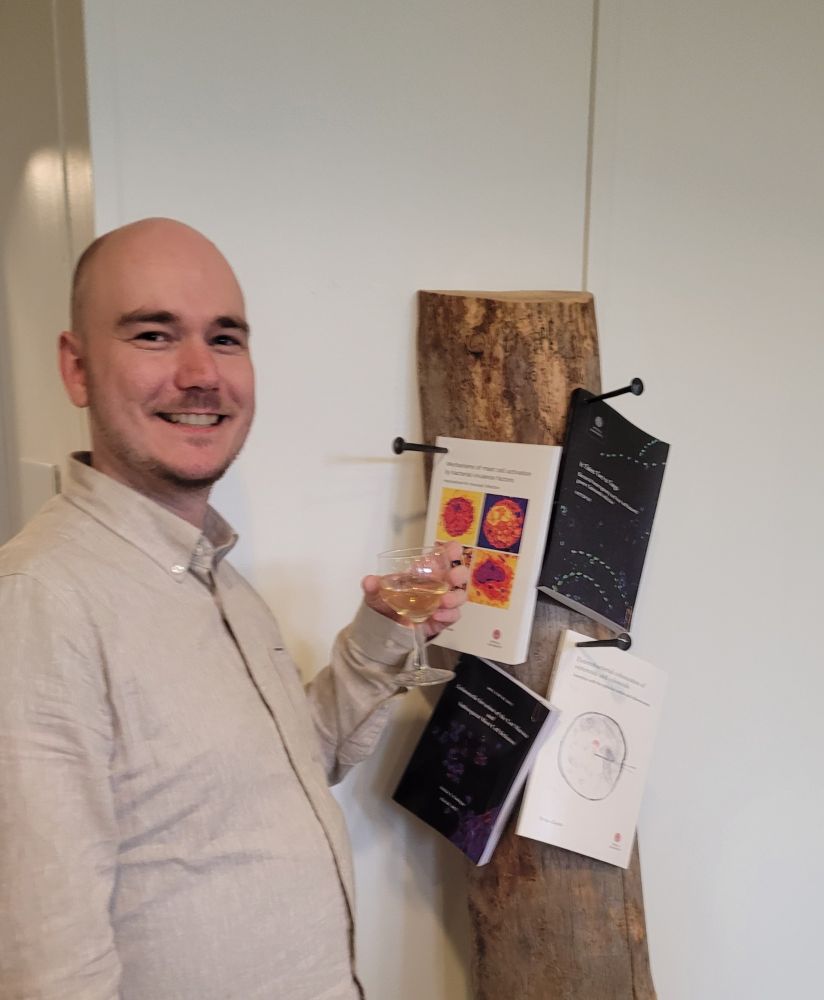
Maria Letizia Di Martino
@mldm.bsky.social
Senior Researcher at Uppsala University | Host-pathogen interactions | Intestinal organoids | Virulence gene regulation | Shigella and Salmonella | Functional genomics | Affiliated to the SellinLab @sellinlab.bsky.social
Pinned
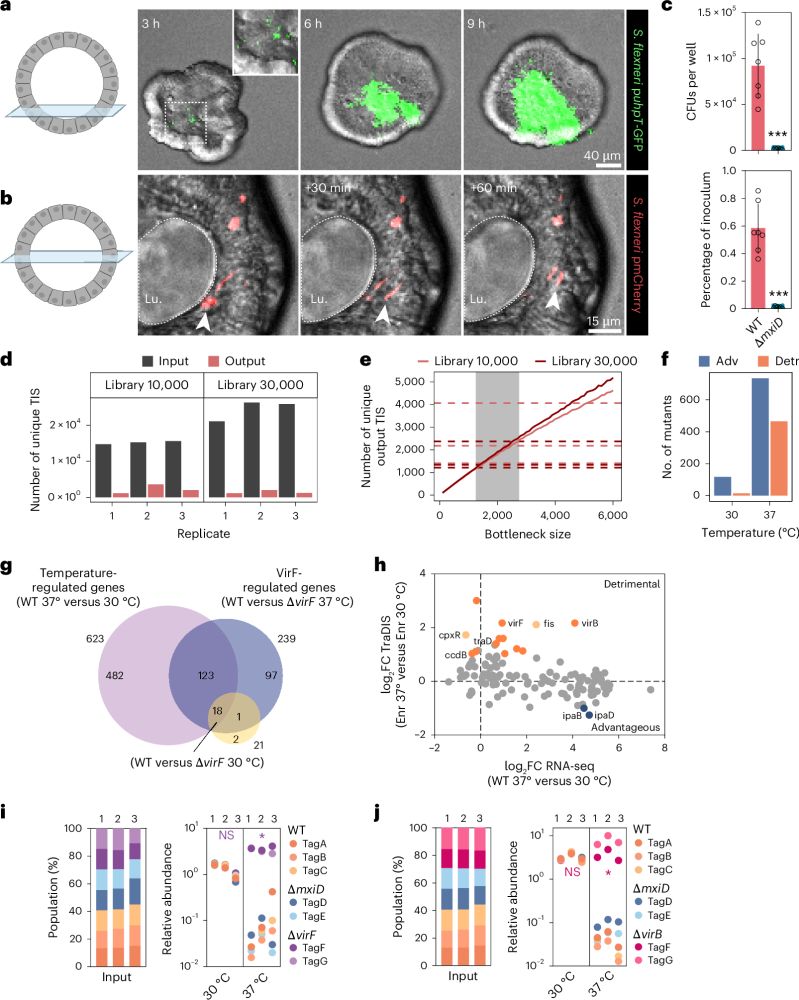
A scalable gut epithelial organoid model reveals the genome-wide colonization landscape of a human-adapted pathogen
Nature Genetics - A genome-wide screen using human gut epithelial organoids combined with transposon-directed insertion sequencing identifies over 100 Shigella flexneri genes required for...
rdcu.be
Thrilled to share our work is finally out at @natgenet.nature.com ! rdcu.be/eqGgf
Combining a scalable human gut organoid model with TraDIS and statistical modeling, we mapped how Shigella colonizes the intestine at genome-wide resolution.
Combining a scalable human gut organoid model with TraDIS and statistical modeling, we mapped how Shigella colonizes the intestine at genome-wide resolution.
Reposted by Maria Letizia Di Martino
IT'S HAPPENING! 💥 I'm psyched to launch the collaboration between @qedscience.bsky.social & @openrxiv.bsky.social @biorxivpreprint.bsky.social! Preprint + q.e.d = your science is out there, and anyone can appreciate it. Let's care about making discoveries, and not on “getting published” (1/3) 👇
November 6, 2025 at 2:49 PM
IT'S HAPPENING! 💥 I'm psyched to launch the collaboration between @qedscience.bsky.social & @openrxiv.bsky.social @biorxivpreprint.bsky.social! Preprint + q.e.d = your science is out there, and anyone can appreciate it. Let's care about making discoveries, and not on “getting published” (1/3) 👇
Reposted by Maria Letizia Di Martino
Enhanced virulence and stress tolerance are signatures of epidemiologically successful Shigella sonnei
@sydneylmiles.bsky.social @katholt.bsky.social
🙏to transformative collaborative effort
www.nature.com/articles/s41...
@sydneylmiles.bsky.social @katholt.bsky.social
🙏to transformative collaborative effort
www.nature.com/articles/s41...
October 13, 2025 at 9:48 PM
Enhanced virulence and stress tolerance are signatures of epidemiologically successful Shigella sonnei
@sydneylmiles.bsky.social @katholt.bsky.social
🙏to transformative collaborative effort
www.nature.com/articles/s41...
@sydneylmiles.bsky.social @katholt.bsky.social
🙏to transformative collaborative effort
www.nature.com/articles/s41...
Reposted by Maria Letizia Di Martino
So excited our antibiotic potentiation story is out 🤩 Led by the extraordinary @manonlang.bsky.social with @fox-science.bsky.social & @amazeld.bsky.social +amazing collaborators @immunobladder.bsky.social @imaneelmeouche.bsky.social 🦠 We believe it can make a difference in #AMR infections!

Uridine as a potentiator of aminoglycosides through activation of carbohydrate transporters
Uridine boosts aminoglycoside treatment efficiency against antibiotic-susceptible as well as antibiotic-resistant E. coli strains.
www.science.org
September 6, 2025 at 9:35 AM
So excited our antibiotic potentiation story is out 🤩 Led by the extraordinary @manonlang.bsky.social with @fox-science.bsky.social & @amazeld.bsky.social +amazing collaborators @immunobladder.bsky.social @imaneelmeouche.bsky.social 🦠 We believe it can make a difference in #AMR infections!
Reposted by Maria Letizia Di Martino
Mast cell subsets respond uniquely to Salmonella infection. Read all about it in our latest paper in EJI. Another chapter in our deciphering of mast cell interactions with enterobacteria, driven by Chris von Beek.
onlinelibrary.wiley.com/doi/10.1002/...
onlinelibrary.wiley.com/doi/10.1002/...

Mast Cell Phenotypic Heterogeneity Impacts the Interplay with Pathogenic Salmonella Typhimurium Bacteria
Mast cell phenotypic features influence anti-bacterial response. Connective tissue-like mast cells sense Salmonella through combined Toll-like-receptor (TLR) signaling and recognition of Type-III-sec....
onlinelibrary.wiley.com
August 24, 2025 at 1:35 PM
Mast cell subsets respond uniquely to Salmonella infection. Read all about it in our latest paper in EJI. Another chapter in our deciphering of mast cell interactions with enterobacteria, driven by Chris von Beek.
onlinelibrary.wiley.com/doi/10.1002/...
onlinelibrary.wiley.com/doi/10.1002/...
Reposted by Maria Letizia Di Martino
Such a rewarding collab it has been with our colleagues at #Novavax to dissect the MoA of their potent Matrix-M adjuvant. This project has really put the imaging skills of @erixoneriksson.bsky.social to the test. The fruits of this joint labour out now in NPJ Vaccines
www.nature.com/articles/s41...
www.nature.com/articles/s41...

Matrix-M adjuvant triggers inflammasome activation and enables antigen cross-presentation through induction of lysosomal membrane permeabilization - npj Vaccines
npj Vaccines - Matrix-M adjuvant triggers inflammasome activation and enables antigen cross-presentation through induction of lysosomal membrane permeabilization
www.nature.com
August 5, 2025 at 8:34 PM
Such a rewarding collab it has been with our colleagues at #Novavax to dissect the MoA of their potent Matrix-M adjuvant. This project has really put the imaging skills of @erixoneriksson.bsky.social to the test. The fruits of this joint labour out now in NPJ Vaccines
www.nature.com/articles/s41...
www.nature.com/articles/s41...
Reposted by Maria Letizia Di Martino
🦠 Launching a bimonthly digest on RNA modifications and related topics in bacteria!🤩 First issue: Summer 2025. Shared here + by email, future ones will be quicker reads! 😅 #rnasky #microsky #ribosome Subscribe and share if you are interested! rnamodifupdates.substack.com/p/rna-modifi...
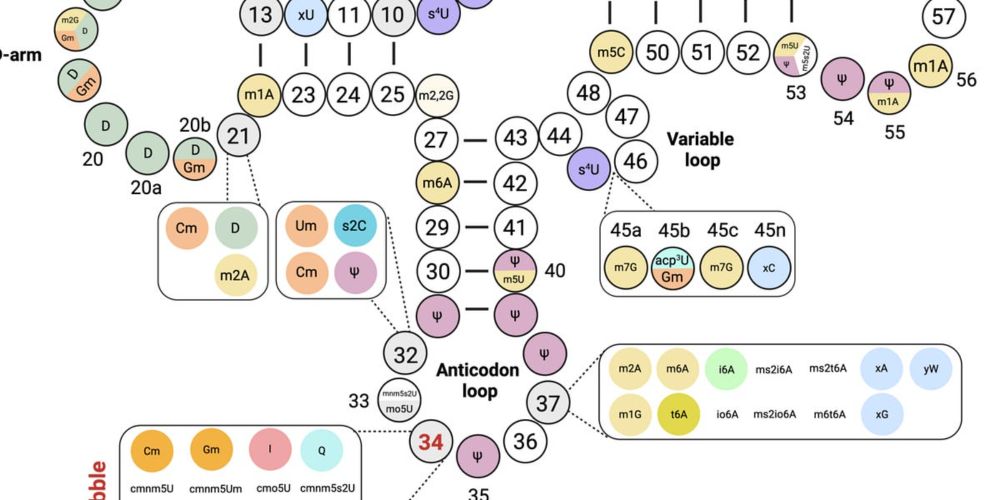
RNA modifications digest Summer 2025
Bimonthly newsletter: RNA modifications and related topics, mostly in bacteria. Summer 2025, first issue!
rnamodifupdates.substack.com
August 15, 2025 at 9:30 AM
🦠 Launching a bimonthly digest on RNA modifications and related topics in bacteria!🤩 First issue: Summer 2025. Shared here + by email, future ones will be quicker reads! 😅 #rnasky #microsky #ribosome Subscribe and share if you are interested! rnamodifupdates.substack.com/p/rna-modifi...
Reposted by Maria Letizia Di Martino
#NatMicroPicks
Decoding Shigella’s Virulence Blueprint 🦠🧬
Combining organoid infection models with genome-wide mutagenesis allows mapping the full set of Shigella genes required for human gut colonization
www.nature.com/articles/s41...
@sellinlab.bsky.social @natgenet.nature.com
Decoding Shigella’s Virulence Blueprint 🦠🧬
Combining organoid infection models with genome-wide mutagenesis allows mapping the full set of Shigella genes required for human gut colonization
www.nature.com/articles/s41...
@sellinlab.bsky.social @natgenet.nature.com

A scalable gut epithelial organoid model reveals the genome-wide colonization landscape of a human-adapted pathogen - Nature Genetics
A genome-wide screen using human gut epithelial organoids combined with transposon-directed insertion sequencing identifies over 100 Shigella flexneri genes required for epithelial colonization.
www.nature.com
August 1, 2025 at 2:35 PM
#NatMicroPicks
Decoding Shigella’s Virulence Blueprint 🦠🧬
Combining organoid infection models with genome-wide mutagenesis allows mapping the full set of Shigella genes required for human gut colonization
www.nature.com/articles/s41...
@sellinlab.bsky.social @natgenet.nature.com
Decoding Shigella’s Virulence Blueprint 🦠🧬
Combining organoid infection models with genome-wide mutagenesis allows mapping the full set of Shigella genes required for human gut colonization
www.nature.com/articles/s41...
@sellinlab.bsky.social @natgenet.nature.com
Reposted by Maria Letizia Di Martino
Could lab-grown mini-organs help scientists research a range of infections? A new study published in Nature Genetics shows how researchers have mapped how the Shigella bacterium infects the human gut.
Read our interview with study co-author — and UTM Biology prof — Lars Barquist at uoft.me/bI7.
Read our interview with study co-author — and UTM Biology prof — Lars Barquist at uoft.me/bI7.

July 15, 2025 at 6:02 PM
Could lab-grown mini-organs help scientists research a range of infections? A new study published in Nature Genetics shows how researchers have mapped how the Shigella bacterium infects the human gut.
Read our interview with study co-author — and UTM Biology prof — Lars Barquist at uoft.me/bI7.
Read our interview with study co-author — and UTM Biology prof — Lars Barquist at uoft.me/bI7.
Excited to be at #EESMicrobiology this week presenting our latest work on #Shigella gut #organoid infection screen from our recent Nature Genetics paper (see below)!
Stop by poster 109 or just look for me, happy to chat and connect!
#Microbiology #Shigella #Organoids #TraDIS
Stop by poster 109 or just look for me, happy to chat and connect!
#Microbiology #Shigella #Organoids #TraDIS
📢ONLINE @natgenet.nature.com
📰A scalable gut epithelial organoid model reveals the genome-wide colonization landscape of a human-adapted pathogen.
By @mldm.bsky.social, @lbarquist.bsky.social, Mikael E. Sellin and colleagues.
⬇️
www.nature.com/articles/s41...
📰A scalable gut epithelial organoid model reveals the genome-wide colonization landscape of a human-adapted pathogen.
By @mldm.bsky.social, @lbarquist.bsky.social, Mikael E. Sellin and colleagues.
⬇️
www.nature.com/articles/s41...

A scalable gut epithelial organoid model reveals the genome-wide colonization landscape of a human-adapted pathogen - Nature Genetics
A genome-wide screen using human gut epithelial organoids combined with transposon-directed insertion sequencing identifies over 100 Shigella flexneri genes required for epithelial colonization.
www.nature.com
June 24, 2025 at 8:20 AM
Excited to be at #EESMicrobiology this week presenting our latest work on #Shigella gut #organoid infection screen from our recent Nature Genetics paper (see below)!
Stop by poster 109 or just look for me, happy to chat and connect!
#Microbiology #Shigella #Organoids #TraDIS
Stop by poster 109 or just look for me, happy to chat and connect!
#Microbiology #Shigella #Organoids #TraDIS
Reposted by Maria Letizia Di Martino
The pcnB gene sustains Shigella flexneri virulence https://www.biorxiv.org/content/10.1101/2025.06.16.659909v1
June 17, 2025 at 3:19 AM
The pcnB gene sustains Shigella flexneri virulence https://www.biorxiv.org/content/10.1101/2025.06.16.659909v1
Reposted by Maria Letizia Di Martino
A study in Nature Genetics establishes the comprehensive genome-wide map of Shigella genes required to infect human intestinal epithelium. go.nature.com/4e7fdKp 🧬 🧪
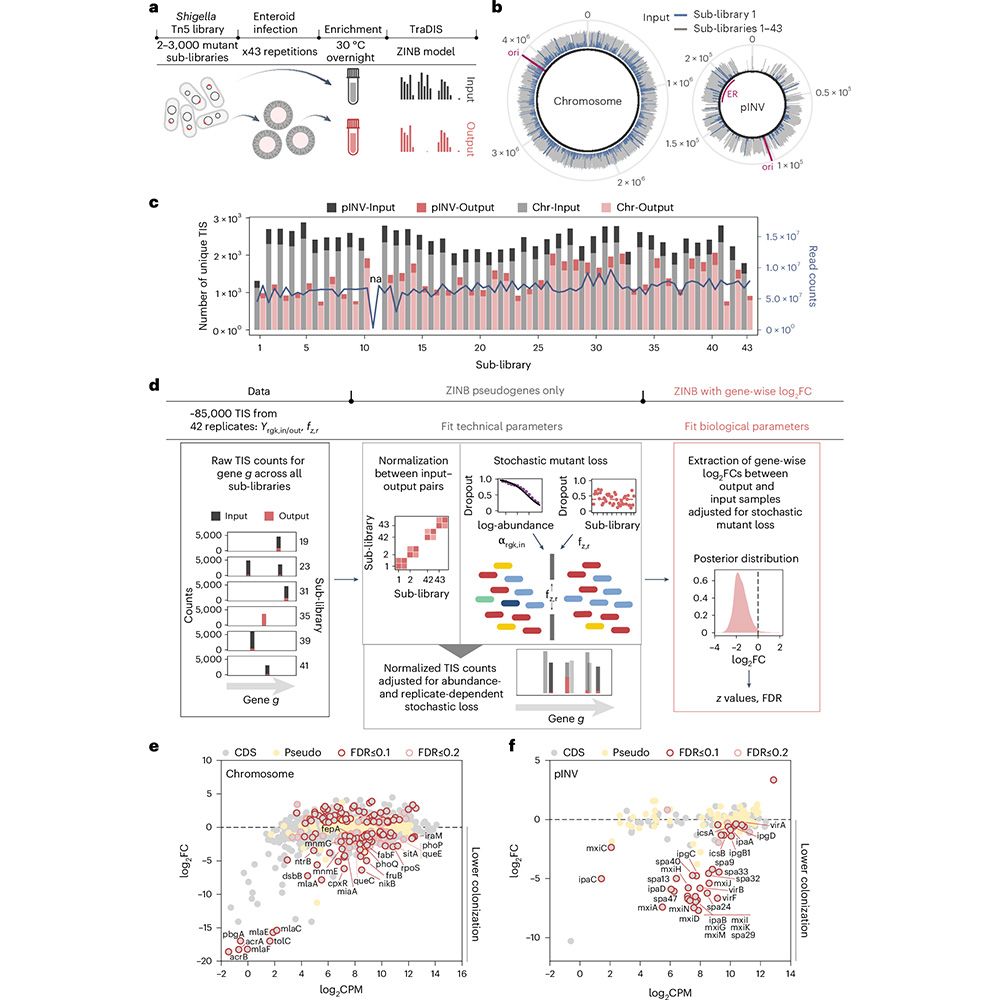
June 17, 2025 at 7:24 PM
A study in Nature Genetics establishes the comprehensive genome-wide map of Shigella genes required to infect human intestinal epithelium. go.nature.com/4e7fdKp 🧬 🧪
New preprint out: www.biorxiv.org/content/10.1...
We followed up on our recent Nature Genetics paper mapping Shigella colonization in intestinal organoids with a deep dive into one of the screen hits: pcnB.
#Shigella #virulence #microsky
We followed up on our recent Nature Genetics paper mapping Shigella colonization in intestinal organoids with a deep dive into one of the screen hits: pcnB.
#Shigella #virulence #microsky
www.biorxiv.org
June 17, 2025 at 9:35 AM
New preprint out: www.biorxiv.org/content/10.1...
We followed up on our recent Nature Genetics paper mapping Shigella colonization in intestinal organoids with a deep dive into one of the screen hits: pcnB.
#Shigella #virulence #microsky
We followed up on our recent Nature Genetics paper mapping Shigella colonization in intestinal organoids with a deep dive into one of the screen hits: pcnB.
#Shigella #virulence #microsky
Reposted by Maria Letizia Di Martino
Thanks @sydneylmiles.bsky.social and @sergemostowylab.bsky.social for writing such a sharp and thoughtful editorial, which covers all the main points and potential caveats of our study published yesterday.
www.nature.com/articles/s41...
www.nature.com/articles/s41...
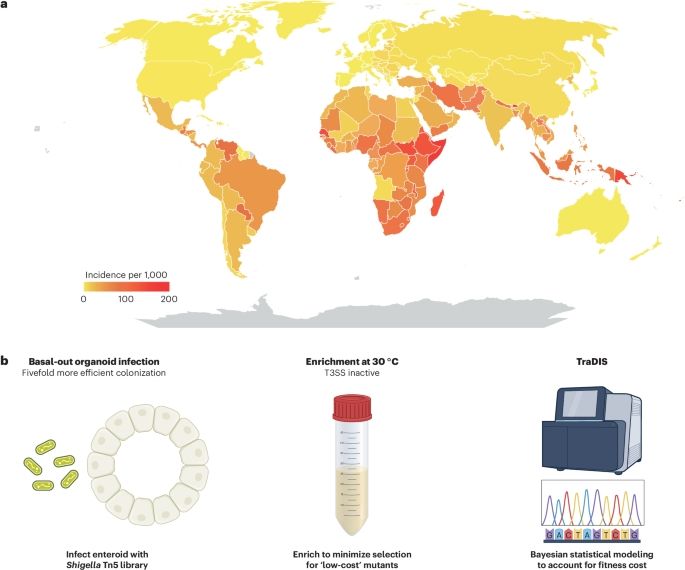
Organoid models advance dysentery control - Nature Genetics
Shigella is a major human pathogen with a stark lack of pipelines linking genome content to clinical pathogenesis. An innovative study using large-scale organoid models, combined with genome-wide muta...
www.nature.com
June 13, 2025 at 11:13 AM
Thanks @sydneylmiles.bsky.social and @sergemostowylab.bsky.social for writing such a sharp and thoughtful editorial, which covers all the main points and potential caveats of our study published yesterday.
www.nature.com/articles/s41...
www.nature.com/articles/s41...
Reposted by Maria Letizia Di Martino
Our latest work combines human gut epithelial #organoid culture with experimental #Shigella #infections, transposon mutagenesis, and statistical modeling. This has led to the mapping of the comprehensive geneset that drives Shigella epithelial colonization.
Out @natgenet.nature.com:
rdcu.be/eqGgf
Out @natgenet.nature.com:
rdcu.be/eqGgf
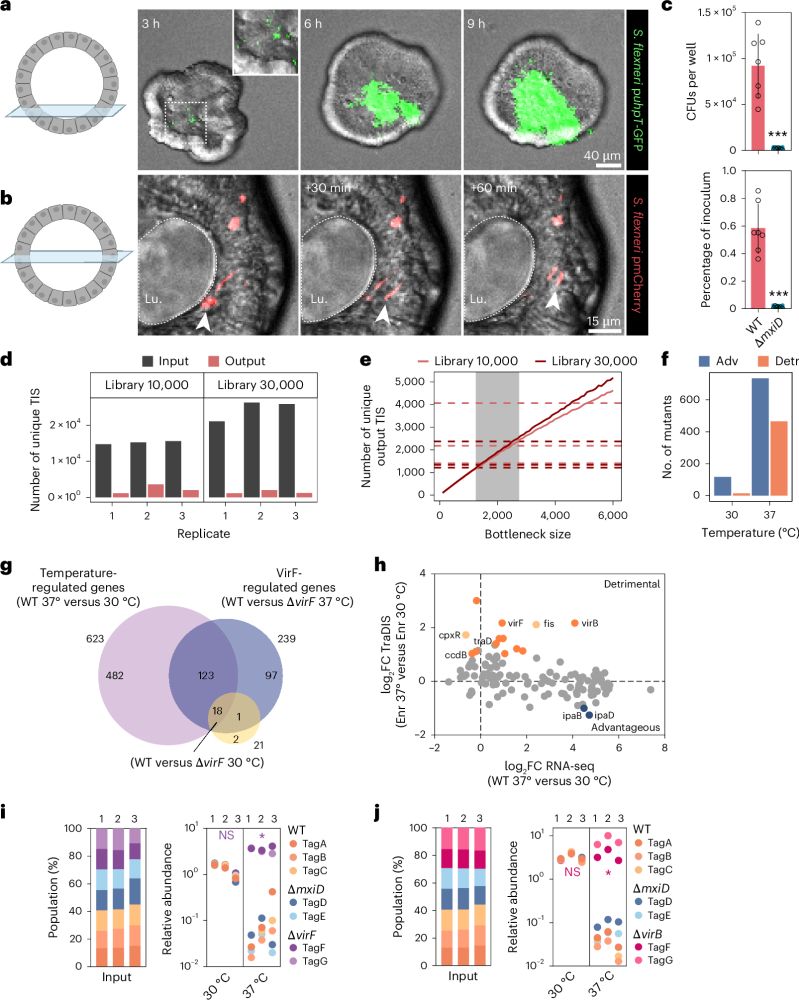
A scalable gut epithelial organoid model reveals the genome-wide colonization landscape of a human-adapted pathogen
Nature Genetics - A genome-wide screen using human gut epithelial organoids combined with transposon-directed insertion sequencing identifies over 100 Shigella flexneri genes required for...
rdcu.be
June 12, 2025 at 2:14 PM
Our latest work combines human gut epithelial #organoid culture with experimental #Shigella #infections, transposon mutagenesis, and statistical modeling. This has led to the mapping of the comprehensive geneset that drives Shigella epithelial colonization.
Out @natgenet.nature.com:
rdcu.be/eqGgf
Out @natgenet.nature.com:
rdcu.be/eqGgf
Reposted by Maria Letizia Di Martino
Very excited about our latest combining advanced cell culture, transposon-insertion sequencing, and statistical modeling to map Shigella virulence determinants in organoid models. Great collaboration w/ @mldm.bsky.social @sellinlab.bsky.social in @natgenet.nature.com
www.nature.com/articles/s41...
www.nature.com/articles/s41...
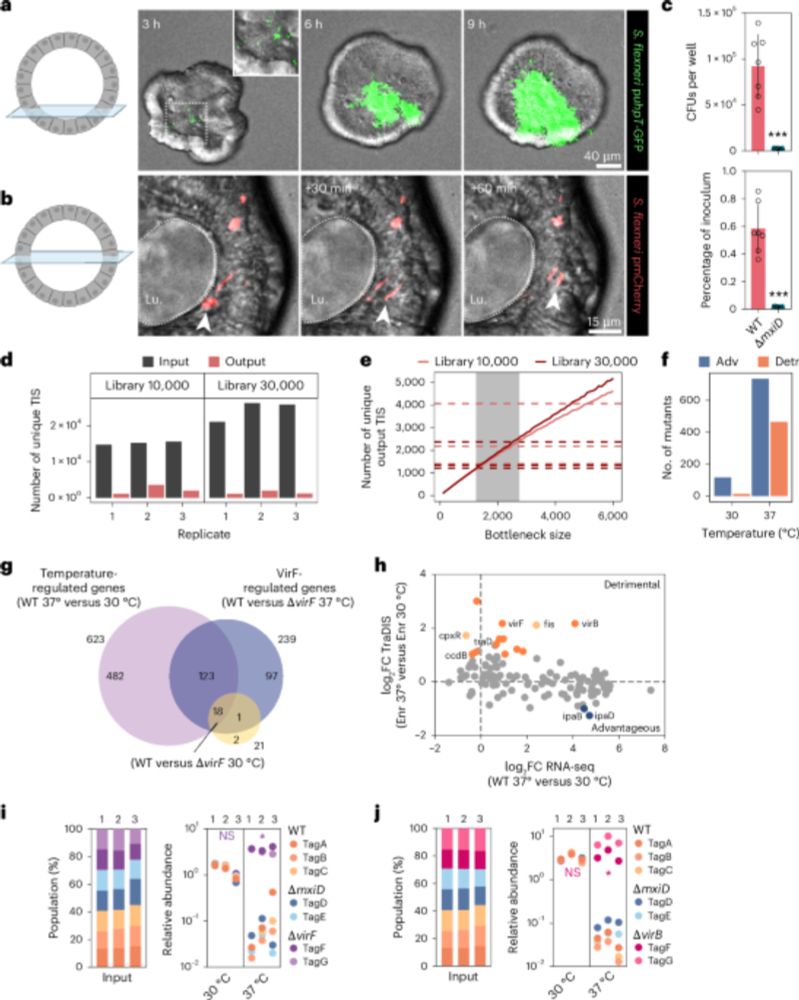
A scalable gut epithelial organoid model reveals the genome-wide colonization landscape of a human-adapted pathogen - Nature Genetics
A genome-wide screen using human gut epithelial organoids combined with transposon-directed insertion sequencing identifies over 100 Shigella flexneri genes required for epithelial colonization.
www.nature.com
June 12, 2025 at 1:19 PM
Very excited about our latest combining advanced cell culture, transposon-insertion sequencing, and statistical modeling to map Shigella virulence determinants in organoid models. Great collaboration w/ @mldm.bsky.social @sellinlab.bsky.social in @natgenet.nature.com
www.nature.com/articles/s41...
www.nature.com/articles/s41...
Reposted by Maria Letizia Di Martino
“we used mini organs, specifically mini-intestines, and infected them with a dangerous bacterium called Shigella” says @mldm.bsky.social
@sellinlab.bsky.social (SciLifeLab & @uu.se) shows that cultured mini-organs can uncover how pathogens cause disease
youtu.be/xG_66ZGd_fk
@sellinlab.bsky.social (SciLifeLab & @uu.se) shows that cultured mini-organs can uncover how pathogens cause disease
youtu.be/xG_66ZGd_fk
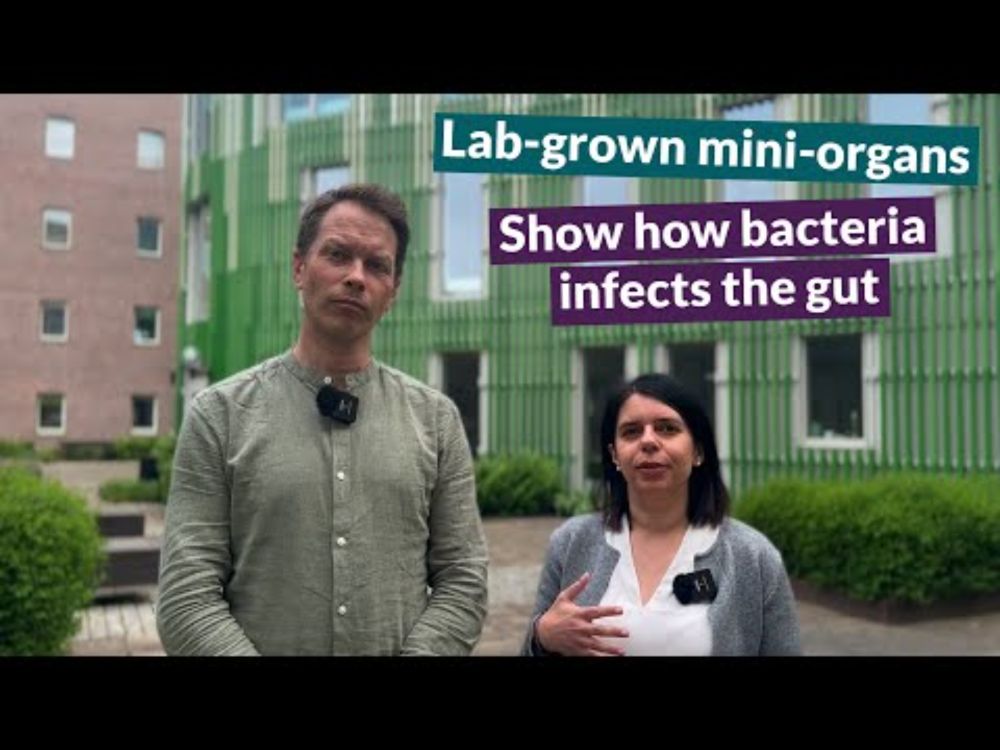
Lab-grown mini-organs help uncover how pathogens cause disease
YouTube video by SciLifeLab
youtu.be
June 12, 2025 at 9:18 AM
“we used mini organs, specifically mini-intestines, and infected them with a dangerous bacterium called Shigella” says @mldm.bsky.social
@sellinlab.bsky.social (SciLifeLab & @uu.se) shows that cultured mini-organs can uncover how pathogens cause disease
youtu.be/xG_66ZGd_fk
@sellinlab.bsky.social (SciLifeLab & @uu.se) shows that cultured mini-organs can uncover how pathogens cause disease
youtu.be/xG_66ZGd_fk
Reposted by Maria Letizia Di Martino
Thanks to lab-grown miniature intestines, researchers at #HIRI & Uppsala University have mapped how Shigella bacteria infect the human gut. This @natgenet.nature.com study opens the door to using cultured mini-organs to investigate a wide range of infections. 📍🦠
www.nature.com/articles/s41...
www.nature.com/articles/s41...
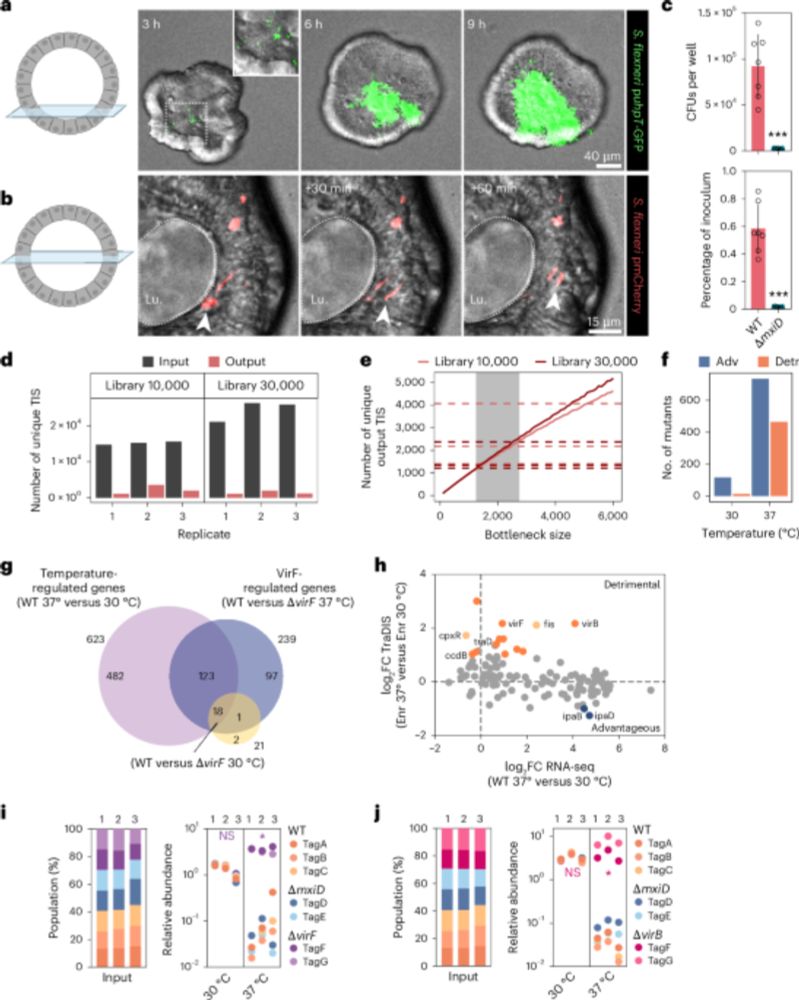
A scalable gut epithelial organoid model reveals the genome-wide colonization landscape of a human-adapted pathogen - Nature Genetics
A genome-wide screen using human gut epithelial organoids combined with transposon-directed insertion sequencing identifies over 100 Shigella flexneri genes required for epithelial colonization.
www.nature.com
June 12, 2025 at 11:29 AM
Thanks to lab-grown miniature intestines, researchers at #HIRI & Uppsala University have mapped how Shigella bacteria infect the human gut. This @natgenet.nature.com study opens the door to using cultured mini-organs to investigate a wide range of infections. 📍🦠
www.nature.com/articles/s41...
www.nature.com/articles/s41...
Thrilled to share our work is finally out at @natgenet.nature.com ! rdcu.be/eqGgf
Combining a scalable human gut organoid model with TraDIS and statistical modeling, we mapped how Shigella colonizes the intestine at genome-wide resolution.
Combining a scalable human gut organoid model with TraDIS and statistical modeling, we mapped how Shigella colonizes the intestine at genome-wide resolution.

A scalable gut epithelial organoid model reveals the genome-wide colonization landscape of a human-adapted pathogen
Nature Genetics - A genome-wide screen using human gut epithelial organoids combined with transposon-directed insertion sequencing identifies over 100 Shigella flexneri genes required for...
rdcu.be
June 12, 2025 at 3:51 PM
Thrilled to share our work is finally out at @natgenet.nature.com ! rdcu.be/eqGgf
Combining a scalable human gut organoid model with TraDIS and statistical modeling, we mapped how Shigella colonizes the intestine at genome-wide resolution.
Combining a scalable human gut organoid model with TraDIS and statistical modeling, we mapped how Shigella colonizes the intestine at genome-wide resolution.
Reposted by Maria Letizia Di Martino
Out now @mbio.bsky.social !: We provide a time-resolved map comparing #Salmonella and #Shigella epithelial colonization strategies in human #enteroids and #colonoids. Connecting the dots among decades of molecular findings reg. underlying virulence factors.
journals.asm.org/doi/10.1128/...
journals.asm.org/doi/10.1128/...
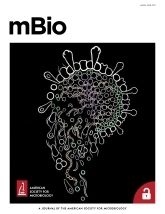
Determinants of divergent Salmonella and Shigella epithelial colonization strategies resolved in human enteroids and colonoids | mBio
Pathogenic bacteria employ partially overlapping sets of virulence factor functions
to colonize host epithelia but can differ markedly in their pathogenesis and disease
kinetics. This work combines ba...
journals.asm.org
May 30, 2025 at 1:45 PM
Out now @mbio.bsky.social !: We provide a time-resolved map comparing #Salmonella and #Shigella epithelial colonization strategies in human #enteroids and #colonoids. Connecting the dots among decades of molecular findings reg. underlying virulence factors.
journals.asm.org/doi/10.1128/...
journals.asm.org/doi/10.1128/...
#EESInfection was very inspiring and enriching! Thanks for all new connections and for the opportunity to present our soon to be published story on TraDIShigella during infection of human intestinal organoids! Stay tuned to read the full story!
And it’s a wrap on #EESInfection! ✨🦠
Huge thanks to all participants, speakers, and organisers who made it a success. Can’t wait for next time!
🏅👏 Congrats to our 5 poster prize winners for their fantastic work!
Stay updated ➡️ embl.org/events/
Huge thanks to all participants, speakers, and organisers who made it a success. Can’t wait for next time!
🏅👏 Congrats to our 5 poster prize winners for their fantastic work!
Stay updated ➡️ embl.org/events/



May 28, 2025 at 2:55 PM
#EESInfection was very inspiring and enriching! Thanks for all new connections and for the opportunity to present our soon to be published story on TraDIShigella during infection of human intestinal organoids! Stay tuned to read the full story!
Reposted by Maria Letizia Di Martino
Only 328 days to go! We're very busy behind the scenes getting thigns ready for the meeting! In the meantime you can add your email address for updates here: coming-soon.embo.org/w26-04
Shigella, the first international meeting
coming-soon.embo.org
May 27, 2025 at 3:22 PM
Only 328 days to go! We're very busy behind the scenes getting thigns ready for the meeting! In the meantime you can add your email address for updates here: coming-soon.embo.org/w26-04
Reposted by Maria Letizia Di Martino
Was great fun to have the emminent @lbarquist.bsky.social visit for the @scilifelab.se The Svedberg seminar this week.
Few can explain computation and statistics so that even wetlab biologists get it, but here is one:
www.utm.utoronto.ca/biology/peop...
www.helmholtz-hiri.de/en/research/...
Few can explain computation and statistics so that even wetlab biologists get it, but here is one:
www.utm.utoronto.ca/biology/peop...
www.helmholtz-hiri.de/en/research/...
May 16, 2025 at 1:04 PM
Was great fun to have the emminent @lbarquist.bsky.social visit for the @scilifelab.se The Svedberg seminar this week.
Few can explain computation and statistics so that even wetlab biologists get it, but here is one:
www.utm.utoronto.ca/biology/peop...
www.helmholtz-hiri.de/en/research/...
Few can explain computation and statistics so that even wetlab biologists get it, but here is one:
www.utm.utoronto.ca/biology/peop...
www.helmholtz-hiri.de/en/research/...
Reposted by Maria Letizia Di Martino
OUT NOW: Inducible transposon mutagenesis identifies bacterial fitness determinants during infection in mice
#microsky 🧪
www.nature.com/articles/s41...
#microsky 🧪
www.nature.com/articles/s41...

Inducible transposon mutagenesis identifies bacterial fitness determinants during infection in mice - Nature Microbiology
InducTn-seq, a method for inducible mutagenesis followed by transposon insertion site sequencing, enables temporal control of transposition to bypass population bottlenecks and enable the quantificati...
www.nature.com
March 27, 2025 at 4:35 PM
OUT NOW: Inducible transposon mutagenesis identifies bacterial fitness determinants during infection in mice
#microsky 🧪
www.nature.com/articles/s41...
#microsky 🧪
www.nature.com/articles/s41...
Reposted by Maria Letizia Di Martino
Interested in predicting AMR in bacteria? We show ignoring phylogenetic structure in genome collections leads to overly optimistic evaluations of machine learning methods for AMR prediction. With @nwheeler443.bsky.social and former PhD student Yanying Yu. 🦠🧫🧬🖥️🧪
www.biorxiv.org/content/10.1...
www.biorxiv.org/content/10.1...
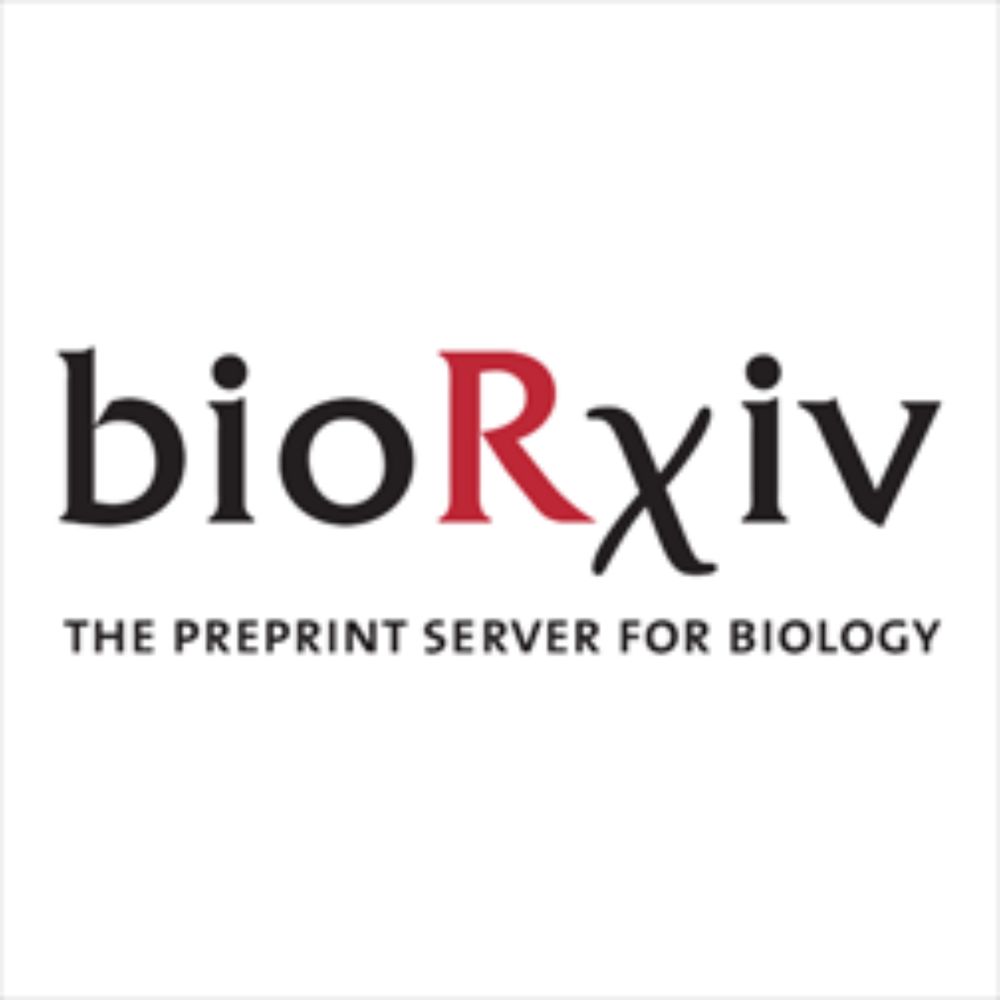
Biased sampling confounds machine learning prediction of antimicrobial resistance
Antimicrobial resistance (AMR) poses a growing threat to human health. Increasingly, genome sequencing is being applied for the surveillance of bacterial pathogens, producing a wealth of data to train...
www.biorxiv.org
January 17, 2025 at 10:08 PM
Interested in predicting AMR in bacteria? We show ignoring phylogenetic structure in genome collections leads to overly optimistic evaluations of machine learning methods for AMR prediction. With @nwheeler443.bsky.social and former PhD student Yanying Yu. 🦠🧫🧬🖥️🧪
www.biorxiv.org/content/10.1...
www.biorxiv.org/content/10.1...


